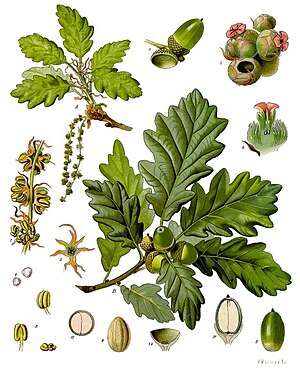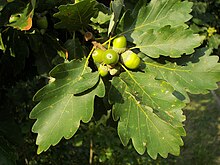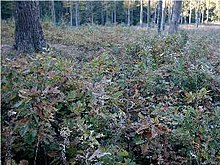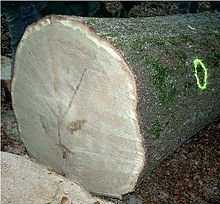Sessile oak
| Grape oak | ||||||||||||
|---|---|---|---|---|---|---|---|---|---|---|---|---|

Sessile Oak ( Quercus petraea ), illustration |
||||||||||||
| Systematics | ||||||||||||
|
||||||||||||
| Scientific name | ||||||||||||
| Quercus petraea | ||||||||||||
| ( Mattuschka ) Liebl. |
The sessile oak ( Quercus petraea (Matt) Liebl.. , Syn. : Quercus sessilis . Ehrh ex Schur , Quercus sessiliflora . Salisb ), including English oak called, is a plant of the genus of oak ( Quercus ) in the family of the beech plants (Fagaceae ). To emphasize their affiliation to the oak genus, the hyphen spelling grape-oak is common in botany .
The sessile oak was tree of the year 2014 in Germany.
description
Vegetative characteristics
The sessile oak grows as a deciduous tree that reaches heights of 25 to 30 (maximum 40) meters and trunk diameters of up to 2 meters. Through their strong taproot it is extremely storm-proof. Like the pedunculate oak , the sessile oak forms St. John's shoots . Their maximum age is 800 to 1000 years. The crown of the tree is arched high on a straight trunk with branches that radiate outwards and are much straighter than the pedunculate oak. The treetop is looser than that of the common oak and the foliage is more evenly distributed. The bark of the sessile oak is smooth when young and pale gray-green shiny, later a thick, deeply lengthwise cracked, gray-brown is bark formed. The bark of the twigs is dark gray, partly red and frosted with gray. The buds are large, pointed cone-shaped, weakly pentagonal, egg-shaped and many-scaly and are clustered on the shoot ends. Each bud scale is light orange-brown with a dark brown tip.
The alternate leaves arranged on the branches are divided into a petiole and a leaf blade. The petiole is 1 to 2 cm long and yellow. The simple, leathery leaf blade is 8 to 12 (rarely up to 16) centimeters long, 5 to 7 (rarely up to 10) cm wide, briefly narrowed in a wedge shape at the base and rounded in five to eight, rarely up to ten narrow bays. The upper side of the leaf is glossy green and the underside is lighter, initially tufted, fluffy and hairy, later balding.
Generative characteristics
The sessile oak is single-sexed separately ( monoecious ). It blooms from April to May. The male kittens are 5 to 8 cm long. The female flowers are terminal as well as in the leaf axils of the young shoots in groups of two to six; they are whitish and spherical with purple scars.
The acorns ripen from September to October. They are heaped (hence the name sessile oak!) On almost sessile fruit cups. The acorns are 1.6 to 2.6 cm long (they are slightly shorter than those of the pedunculate oak). The fruit cup covers about half of the acorn and is densely hairy. The acorns serve as food for various animals and are spread by them. The jay in particular ensures the spread of the sessile oak ( jay seeds) by creating food depots.
The number of chromosomes is 2 n = 24.
Differentiation from English oak

The English oak and the sessile oak are very similar. Many systematists and geneticists see the sessile oak as just a local breed of the pedunculate oak. However, there are some differences in distribution and morphology: The sessile oak is preferred in the hill and low mountain areas, for example in the Spessart and the Palatinate Forest . Its fruits are clustered on very short stems. The leaves are stalked two to three inches long. The leaf base is wedge-shaped and not eyed. In the middle spreading area of the leaves, the side nerves never end in the bays.
Pedunculate oak and sessile oak can hybridize. It is unclear whether such bastards play a role in real populations. Usually plants with intermediate characteristics turned out to belong to one of the two species.
Systematics
There are five subspecies:
- Quercus petraea subsp. austrotyrrhenica Brullo, Guarino & Siracusa : It occurs in southern Italy and Sicily.
- Quercus petraea subsp. huguetiana Franco & G.López : It occurs in northern Spain.
- Quercus petraea subsp. petraea : It occurs from Europe to Turkey.
- Quercus petraea subsp. pinnatiloba (K. Koch) Menitsky : It occurs from Turkey to Syria.
- Quercus petraea subsp. polycarpa (Shur) Soó : It occurs from Slovakia to the Balkan Peninsula, in Crimea and from Turkey to northern Iran.
Cultivated forms
- 'Mespilifolia':
This rare form can grow up to 16 meters high with a trunk diameter of up to one meter. The leaves are oblong-lanceolate, up to 22 cm long and 3–5 cm wide; they have a thickened, somewhat bulged, unlobed edge; sometimes some leaves have an irregular lobe. The petiole is often dark red. - 'Columna':
It is either a variety of the sessile oak ( Quercus petraea ) or a cross between English and sessile oak ( Quercus × rosacea ). It is densely branched, the leaves are barely lobed, the variety is less susceptible to powdery mildew. - 'Laciniata':
With slit leaves.
Occurrence
The sessile oak is after the English oak in Central Europe the most widespread species of oak. Their distribution area extends from Italy and northern Greece in the south to the British Isles and southern Scandinavia in the north. It occurs from northern Spain in the west to Poland, southwest Russia and the Black Sea to northern Iran in the east. Compared to the English oak, its range does not extend so far to the east; it prefers Atlantic and sub-Atlantic climates. The sessile oak rises in the Southern Alps up to 1,100 m above sea level. NN , so z. B. in the special forest reserve Plontabuora .
The sessile oak occurs on dry to fresh, medium to deep stone and clay soils (the scientific species name “petraea” (rock) indicates the stone soils). It also tolerates poorly nutrient-supplied locations. In contrast to the English oak, it avoids soils that are waterlogged and humid . The sessile oak, which needs light, is being replaced in normal locations in Central Europe by the shade-tolerant, competitive red beech and only occurs as a secondary tree species . For this reason, it only forms the stock at special locations: on strict clay soils in oak-hornbeam forests and on nutrient-poor, dry sandy soils in oak-birch forests and oak-pine forests. In the sub-Mediterranean climatic area it forms mixed forests with the downy oak and the Turkey oak . She is a character species of the Querco-Fagetea class.
Many oak forests in Central Europe are of anthropogenic origin. They are intergrown middle forests , as the sessile oak can withstand the middle forest management better than the common beech due to its ability to shed its branches. The oaks have always been specifically promoted because of their valuable wood and the fruits they use as fodder ( acorn fattening ).
use
The sessile oak is a ring-pored heartwood tree . The yellowish-white sapwood is only narrow, the heartwood is light to dark brown in color. The mean bulk density is 0.65 (0.39-0.93) g / cm³. The oak wood is hard, tough, very durable and easy to work with. The wood of the sessile oak is used in a variety of ways: in hydraulic engineering, as construction timber, for sleepers and piles, in interior construction for stairs and floors and as solid furniture wood. High-quality oak mostly comes from the sessile oak and is used for veneer production and for building barrels and barrels . Famous stocks of valuable wood can be found in the Spessart , Steigerwald and Palatinate Forest . Oak wood is also ideal as firewood. The sessile oak is very suitable as a park tree , as it sprouts early in the year and retains its leaves for the longest in autumn.
The acorns, which are inedible raw for humans due to bitter substances, are very nutritious and contain up to 38% starch. Acorn malt is, however, quite suitable for making beer . Acorns are also suitable for making fruit coffee .
In the past, the oak forests were more important for pig fattening than for wood. Many of the stocks that are valuable today were created for this purpose or for deforestation. Before the large-scale field forage cultivation from the 19th century, forest pasture was the most important type of pig fattening. The saying "The best ham grows on the oaks" comes from this time.
Another use was that of the bark as a tannery . For this purpose, the sessile oak was cultivated as coppice , so-called tunnels , harvested every 15 to 20 years, the trunks curled and the bark peeled off. The dried bark has a tannic acid content of 8 to 20%.
pharmacology
The dried, bark-free bark of young twigs and cane rashes (Quercus cortex) is used as a medicinal drug.
It contains up to 20 percent tannins of the catechin type (predominantly oligomeric proanthocyanidins ), partly also ellagitannins ; the cytosol quercitol and triterpenes .
The focus of the applications is the astringent, drying, anti-blood and itch-relieving properties, but also the antiseptic effect of the tannins, which promotes healing.
Decoctions of the oak bark are accordingly used externally for baths or compresses for skin diseases, increased foot perspiration, frost damage, hemorrhoids and anal fissures; Also for rinsing and gargling with slight inflammation in the mouth and throat.
literature
- Joachim Krahl-Urban: The oaks. Forest monograph of the sessile oak and the English oak . Parey, Hamburg / Berlin 1959.
- Heinrich Spiecker : To control the growth in thickness and the cleaning of branches of sessile and English oak (Quercus petraea (Matt.) Liebl. And Quercus robur L.) . Series of publications of the state forest administration of Baden-Württemberg, Volume 72. Forestry experimental and research institute, Freiburg im Breisgau 1991.
- Gregor Aas : Investigations into the separation and cross-ability of English oak and sessile oak (Quercus robur L. and Q [uercus] petraea (Matt.) Liebl.) (Dissertation). Munich 1989.
- Ingrid and Peter Schönfelder : The new handbook of medicinal plants. Franckh-Kosmos-Verlagsgesellschaft, 2011, ISBN 3-440-09387-5 .
Web links
- Sessile oak. In: FloraWeb.de.
- Sessile oak . In: BiolFlor, the database of biological-ecological characteristics of the flora of Germany.
- Profile and distribution map for Bavaria . In: Botanical Information Hub of Bavaria .
- Quercus petraea Liebl. In: Info Flora , the national data and information center for Swiss flora . Retrieved October 3, 2015.
- Distribution in the northern hemisphere according to Eric Hultén
- Thomas Meyer: Data sheet with identification key and photos at Flora-de: Flora von Deutschland (old name of the website: Flowers in Swabia )
- Podcast The Sessile Oak - Tree of the Year 2014 on forstcast.net
- Tree species profile sessile oak - information on forest research and forest practice of the LWF (Bavarian State Institute for Forests and Forestry)
photos
- Diseases of the sessile oak on baumportal.de
- Pictures on uni-graz.at
Individual evidence
- ↑ a b Gregor Aas: Encyclopedia of the woody plants. (PDF) Quercus petraea. In: Encyclopedia of the Woody Plant. Ecological-Botanical Garden of the University of Bayreuth, p. 1, 4 , accessed on January 1, 2015 : “Typical for branches in winter is an accumulation of buds at the tip of the shoots, whereby the shape and size of the individual buds vary considerably. Mostly they are pointedly conical and weakly pentagonal, the terminal buds usually somewhat larger than the lateral ones. "
- ↑ Grape oak is tree of the year on Deutsche Welle Online from October 24, 2013 (accessed October 25, 2013)
- ↑ a b Erich Oberdorfer : Plant-sociological excursion flora for Germany and neighboring areas. 8th edition. Verlag Eugen Ulmer, Stuttgart 2001, ISBN 3-8001-3131-5 , p. 317.
- ↑ Leaf morphology and genetic fingerprint as an aid in identifying sessile and English oak. In: waldwissen.net. Retrieved January 28, 2017.
- ↑ Rafaël Govaerts (Ed.): Quercus - data sheet at World Checklist of Selected Plant Families of the Board of Trustees of the Royal Botanic Gardens, Kew. Retrieved October 4, 2015.
- ↑ https://braumagazin.de/article/projekt-eichelbier/






